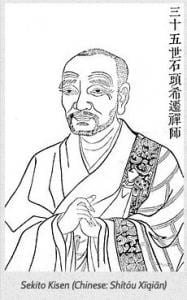
This year at both the Nebraska Zen Center and the Vine of Obstacles: Online Support for Zen Training we’ve studied one of the essential texts in the Sōtō Zen liturgy, “Harmony of Difference and Sameness” (Japanese: Sandōkai; Chinese: Cāntóngqì 參同契), supported by Branching Streams Flow in the Darkness: Zen Talks on the Sandokai by Shunryu Suzuki Roshi. In order to work my edge and offer something fresh to students, I translated the text as we were going along. You’ll find that below.
The original text has forty-four terse lines with five characters in each line. The Sōtō Zen Text Project version of the “Harmony of Difference and Sameness” – here – that’s is used by many Sōtō groups in the US, at least, is well done and flows well as a chant. However, because translating a text is a powerful method for understanding and appreciating what’s inside the meaning, I reworked it and shared the results with students – and now here for you.
In translation work, there is no such thing as “one right way,” because there are many ways that the ideograms can be expressed in English. The version below is offered in the spirit of “it could be this way too,” although this is living rendering and may well change in the future, including smoothing out some of the rough edges. I try to stay as close to the original as possible and allow the text room for expression, even if that results in something that’s a bit awkward. If you give it a read, you’ll see what I mean.
And although a good deal could be said about the details of this translation, I’ll make just one note. 理 (lǐ) comes up twice in the text. The Sōtō Zen Text Project version translates it two ways, as “sameness” and “principle” (as in “According with sameness is still not enlightenment” and “Principle responds like arrow points meet”). I follow David Hinton, translating 理 (lǐ) as “inner pattern.” Hinton writes,
“The philosophical meaning of inner-pattern, which originally referred to the veins and markings in a precious piece of jade, is something akin to what we call ‘natural law.’ It is the system of principles or patterns that governs the unfolding of tzu-jan [self-ablaze], or the manifestations of origin-ch’i [a single breath-force surging through its perpetual transformations] as it takes on the forms of the ten thousand things. Inner-pattern therefore weaves Absence and Presence into a single boundless tissue.” (1)
Here it is:
The Agreement of Difference and Sameness
By Shítóu Xīqiān (700-790) 石頭希遷
The Indian-dust great-sage mind
Is mutually, intimately entrusted east-west
The root of people is sharp-dull
In the Way – no north-south ancestor
The source of awareness shines moonlight bright
The undercurrent pours through branching streams
Grasping it is original confusion
Inner-pattern accordance is also not enlightenment
Every field is gate-to-gate
Mutually revolving and not mutually revolving
Involvement revolves and changes each other
Not so according to position and place
The root nature of form appears to differ
Sounds primarily distinguish happy from bitter
In darkness, elevated and common speech come together
In brightness, phrases are clear and muddy
Four elements return to self-nature
Like a child has their mother
Fire hot, wind moves
Water wet, earth hard
Eye-form, ear-sounds
Nose-fragrance, tongue-salty or vinegary
One-by-one, dharmas depend thus
Depending on roots, leaves scatter
The root doesn’t wait to return to the branch
Revered and humble use their speech
When light, within there is dark
Do not meet by means of dark
When dark, within there is light
Do not meet by means of light.
The opposition of light and dark
is like the front and back [foot] stepping.
All living beings have meritorious activity
Expressed according to function and place
Things exist [like] box and lid join
Inner pattern responds [like] arrow points meet
Receiving words, understand the school
Self-sustaining customs won’t do
Seeing everything [yet] not understanding the Way
How is moving [your] foot knowing the road?
Stepping forward is not far or near
Bewildered, hard separation from mountains and rivers
Solemnly say, “Person who participates in the mystery,
Do not fritter away the time”
(1) David Hinton, No-Gate Gateway: The Original Wu-Men Kuan, p. 134.

Dōshō Port began practicing Zen in 1977 and now co-teaches at the Nebraska Zen Center with his wife, Tetsugan Zummach Ōshō. Dōshō also teaches with the Vine of Obstacles: Online Support for Zen Training, an internet-based Zen community. Dōshō received dharma transmission from Dainin Katagiri Rōshi and inka shōmei from James Myōun Ford Rōshi in the Harada-Yasutani lineage. He is the author of Keep Me In Your Heart a While: The Haunting Zen of Dainin Katagiri.











